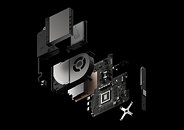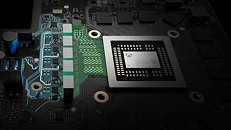Monday, June 12th 2017

Xbox One X Hardware Specs Give Gaming Desktops a Run for their Money
Microsoft Sunday dropped its mic with the most powerful game console on paper, the Xbox One X, formerly codenamed "Project Scorpio." The bottom-line of this console is that it enables 4K Ultra HD gaming at 60 Hz. Something like this requires you to spend at least $1,200 on a gaming desktop right now. Unlike a Windows 10 PC that's been put together by various pieces of hardware, the Xbox One X is built on a closed ecosystem that's tightly controlled by Microsoft, with heavily optimized software, and a lot of secret sauce the company won't talk about. The console still puts up some mighty impressive hardware specs on paper.
To begin with, at the heart of the Xbox One X is a semi-custom SoC Microsoft co-developed with AMD, built on TSMC's 16 nm FinFET node (the same one NVIDIA builds its "Pascal" GPUs on). This chip features a GPU with almost quadruple the single-precision floating point compute power as the one which drives the Xbox One. It features 40 Graphics CoreNext (GCN) compute units (2,560 stream processors) based on one of the later versions of GCN (likely "Polaris"). The GPU is clocked at 1172 MHz. The other big component of the SoC is an eight-core CPU based on an unnamed micro-architecture evolved from "Jaguar" rather than "Bulldozer" or even "Zen." The eight cores are arranged in two quad-core units of four cores, each; with 4 MB of L2 cache. The CPU is clocked at 2.30 GHz.The third major component of the Xbox One X SoC is the 384-bit wide GDDR5 memory controller, wired to 12 GB of memory. This memory is used both as system- and graphics-memory, and is the most ideal implementation of AMD's hUMA (heterogeneous unified memory architecture), where there's no visible partition between the system and graphics memory on the physical memory, and depending on the usage scenario, any amount of memory can be used by the CPU and GPU components. Developers are still forced to build their games under the assumption that the system only has 8 GB of memory; so that the remaining 4 GB is used as a kind of "guarantee" that 4K UHD @60 Hz runs smoothly. The total memory bandwidth available is a staggering 326 GB/s.
The SoC features an integrated audio CODEC with 7.1-channel output over HDMI, with support for Dolby Atmos, and HRTF, a new audio format Microsoft developed for the Hololens, which is optimized for VR.
A 1 TB 2.5-inch SATA hard drive comes standard on the Xbox One X. You can swap this drive out for larger HDDs, or faster SATA SSDs. You can also plug in external storage devices over the console's USB 3.0 ports. The console's operating system resides on a smaller eMMC chip that isn't accessible to end-users. The 1 TB HDD is used to store games you've downloaded from your online library à la Steam.
Microsoft switched from bulky external power bricks to internal PSUs with the Xbox One S, and the trend carries forward with the Xbox One X. Powering the whole thing is a 275W internal power-supply. A large fan-heatsink cools the SoC and GDDR5 memory chips.
Source:
Eurogamer.net
To begin with, at the heart of the Xbox One X is a semi-custom SoC Microsoft co-developed with AMD, built on TSMC's 16 nm FinFET node (the same one NVIDIA builds its "Pascal" GPUs on). This chip features a GPU with almost quadruple the single-precision floating point compute power as the one which drives the Xbox One. It features 40 Graphics CoreNext (GCN) compute units (2,560 stream processors) based on one of the later versions of GCN (likely "Polaris"). The GPU is clocked at 1172 MHz. The other big component of the SoC is an eight-core CPU based on an unnamed micro-architecture evolved from "Jaguar" rather than "Bulldozer" or even "Zen." The eight cores are arranged in two quad-core units of four cores, each; with 4 MB of L2 cache. The CPU is clocked at 2.30 GHz.The third major component of the Xbox One X SoC is the 384-bit wide GDDR5 memory controller, wired to 12 GB of memory. This memory is used both as system- and graphics-memory, and is the most ideal implementation of AMD's hUMA (heterogeneous unified memory architecture), where there's no visible partition between the system and graphics memory on the physical memory, and depending on the usage scenario, any amount of memory can be used by the CPU and GPU components. Developers are still forced to build their games under the assumption that the system only has 8 GB of memory; so that the remaining 4 GB is used as a kind of "guarantee" that 4K UHD @60 Hz runs smoothly. The total memory bandwidth available is a staggering 326 GB/s.
The SoC features an integrated audio CODEC with 7.1-channel output over HDMI, with support for Dolby Atmos, and HRTF, a new audio format Microsoft developed for the Hololens, which is optimized for VR.
A 1 TB 2.5-inch SATA hard drive comes standard on the Xbox One X. You can swap this drive out for larger HDDs, or faster SATA SSDs. You can also plug in external storage devices over the console's USB 3.0 ports. The console's operating system resides on a smaller eMMC chip that isn't accessible to end-users. The 1 TB HDD is used to store games you've downloaded from your online library à la Steam.
Microsoft switched from bulky external power bricks to internal PSUs with the Xbox One S, and the trend carries forward with the Xbox One X. Powering the whole thing is a 275W internal power-supply. A large fan-heatsink cools the SoC and GDDR5 memory chips.




132 Comments on Xbox One X Hardware Specs Give Gaming Desktops a Run for their Money
example: cinebench r15 single-core result for a4-5000 (@ default 1500mhz) should be 30-35.
there are considerable architectural differences between (ultra)mobile soc-s with jaguar cores (or atom cores) and today's full-fat deskop cpu-s.
That said, Microsoft seriously came out swinging because of the flak they got for putting out a weaker-than-PS4 Xbox One. One could argue they over-corrected though, as reflected by the $500 price tag. I think too many companies are going too gun-ho over VR when the demand really isn't there.
Kaby Lake have ~>60% better IPC, combined with significantly higher clocks.
This kind of statement leads to misunderstandings and misinformation which are a part of what causes so much mistrust within the industry at Microsoft, aside from their own shenanigans.You can't be serious with that... My 4 year old pc is better spec-wise than the Scorpio.At 4k res, turn off AA completely. It isn't needed at that resolution and will completely waste GPU resources. At 4k, I'm seeing a solid 120fps minimum on most games. AA is off and AF is on 4X[forced through the driver]. Performance is smooth and fluid. And before you argue, TRY IT!
It seems you guys still can't wrap your head around anything more than 'raw specs'. Most only care about the end result.
To compare IPC, you need to be able to calculate it correctly first and fore most, otherwise you look like a doofus.
IPC = Instructions per cycle. The name alone should be enough to realize you can't multiply frequency and physical core count to determine it for a given CPU.
IPC is greatly affected by the CPUs cache and memory heirarchy as well. And for that you have to know the "stalls" at each level, if the levels are unified or not (L1 cache are split into data and instruction portions) but l2 and l3 are typically unified and then you need to know the percentage of data that is pulled from each level.
I dont know about the twice the power claim. Those jaguar cores are weak as hell though.
AF at 4X is going to give you terribly blurred textures in certain angles. Not even a Titan Xp can pull the heaviest current games in 4K at 60 Hz at the highest detail level, so a gaming console with a fraction of the performance is certainly not going to do that.IPC is performance per core. Of course more cores may provide more total theoretical performance, but in real workloads things don't scale like that. And since we're talking of a gaming console, more cores is certainly not going to mitigate the slow single core performance.
The task of rendering can only be split to a small degree, so in any game the performance of a single core is the deciding factor for real performance. The other cores mainly help to do non-rendering tasks, OS tasks etc.
To estimate IPC you take one or more (scalable) benchmarks, and divide the score by clock speed.